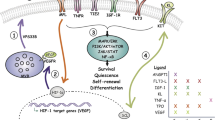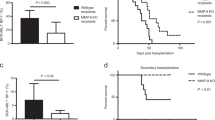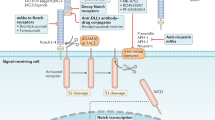Abstract
Interaction of cancer cells with their microenvironment generated by stromal cells is essential for tumor cell survival and influences the localization of tumor growth. Here we demonstrate that hedgehog ligands secreted by bone-marrow, nodal and splenic stromal cells function as survival factors for malignant lymphoma and plasmacytoma cells derived from transgenic Eμ-Myc mice or isolated from humans with these malignancies. Hedgehog pathway inhibition in lymphomas induced apoptosis through downregulation of Bcl2, but was independent of p53 or Bmi1 expression. Blockage of hedgehog signaling in vivo inhibited expansion of mouse lymphoma cells in a syngeneic mouse model and reduced tumor mass in mice with fully developed disease. Our data indicate that stromally induced hedgehog signaling may provide an important survival signal for B- and plasma-cell malignancies in vitro and in vivo. Disruption of this interaction by hedgehog pathway inhibition could provide a new strategy in lymphoma and multiple myeloma therapy.
This is a preview of subscription content, access via your institution
Access options
Subscribe to this journal
Receive 12 print issues and online access
$209.00 per year
only $17.42 per issue
Buy this article
- Purchase on Springer Link
- Instant access to full article PDF
Prices may be subject to local taxes which are calculated during checkout





Similar content being viewed by others
References
Kawano, M. et al. Autocrine generation and requirement of BSF-2/IL-6 for human multiple myelomas. Nature 332, 83–85 (1988).
Tassone, P. et al. Combination therapy with interleukin-6 receptor superantagonist Sant7 and dexamethasone induces antitumor effects in a novel SCID-hu in vivo model of human multiple myeloma. Clin. Cancer Res. 11, 4251–4258 (2005).
Li, Y. et al. DF3/MUC1 signaling in multiple myeloma cells is regulated by interleukin-7. Cancer Biol. Ther. 2, 187–193 (2003).
Kimlinger, T. et al. Differential expression of vascular endothelial growth factors and their receptors in multiple myeloma. Haematologica 91, 1033–1040 (2006).
Moller, C., Stromberg, T., Juremalm, M., Nilsson, K. & Nilsson, G. Expression and function of chemokine receptors in human multiple myeloma. Leukemia 17, 203–210 (2003).
Jundt, F. et al. Jagged1-induced Notch signaling drives proliferation of multiple myeloma cells. Blood 103, 3511–3515 (2004).
Georgii-Hemming, P. et al. Insulin-like growth factor I is a growth and survival factor in human multiple myeloma cell lines. Blood 88, 2250–2258 (1996).
Kobune, M. et al. Indian hedgehog gene transfer augments hematopoietic support of human stromal cells including NOD/SCID–β 2 m−/− repopulating cells. Blood 104, 1002–1009 (2004).
Sacedon, R. et al. Sonic hedgehog is produced by follicular dendritic cells and protects germinal center B cells from apoptosis. J. Immunol. 174, 1456–1461 (2005).
Stewart, G.A. et al. Sonic hedgehog signaling modulates activation of and cytokine production by human peripheral CD4+ T cells. J. Immunol. 169, 5451–5457 (2002).
Dyer, M.A., Farrington, S.M., Mohn, D., Munday, J.R. & Baron, M.H. Indian hedgehog activates hematopoiesis and vasculogenesis and can respecify prospective neurectodermal cell fate in the mouse embryo. Development 128, 1717–1730 (2001).
Gering, M. & Patient, R. Hedgehog signaling is required for adult blood stem cell formation in zebrafish embryos. Dev. Cell 8, 389–400 (2005).
Lee, J., Platt, K.A., Censullo, P. & Ruiz i Altaba, A. Gli1 is a target of Sonic hedgehog that induces ventral neural tube development. Development 124, 2537–2552 (1997).
Marigo, V. & Tabin, C.J. Regulation of patched by sonic hedgehog in the developing neural tube. Proc. Natl. Acad. Sci. USA 93, 9346–9351 (1996).
Duman-Scheel, M., Weng, L. & Xin, S. Hedgehog regulates cell growth and proliferation by inducing Cyclin D and Cyclin E. Nature 417, 299–344 (2002).
Xie, J. et al. Activating Smoothened mutations in sporadic basal-cell carcinoma. Nature 391, 90–92 (1998).
Goodrich, L.V. & Scott, M.P. Hedgehog and Patched in neural development and disease. Neuron 21, 1243–1257 (1998).
Marino, S. Medulloblastoma: developmental mechanisms out of control. Trends Mol. Med. 11, 17–22 (2005).
Aszterbaum, M. et al. Ultraviolet and ionizing radiation enhance the growth of BCCs and trichoblastomas in patched heterozygous knockout mice. Nat. Med. 5, 1285–1291 (1999).
Tostar, U. et al. Deregulation of the hedgehog signaling pathway: a possible role for the PTCH and SUFU genes in human rhabdomyoma and rhabdomyosarcoma development. J. Pathol. 208, 17–25 (2006).
Oro, A.E. et al. Basal cell carcinomas in mice overexpressing sonic hedgehog. Science 276, 817–821 (1997).
Watkins, D.N. et al. Hedgehog signaling within airway epithelial progenitors and in small-cell lung cancer. Nature 422, 313–317 (2003).
Karhadkar, S.S. et al. Hedgehog signaling in prostate regeneration, neoplasia and metastasis. Nature 431, 707–712 (2004).
Thayer, S.P., di Magliano, M.P. & Heiser, P.W. Hedgehog is an early and late mediator of pancreatic cancer tumourigenesis. Nature 425, 851–856 (2003).
Berman, D.M., Karhadkar, S.S. & Maitra, A. Widespread requirement for Hedgehog ligand stimulation in growth of digestive tract tumors. Nature 425, 846–851 (2003).
Adams, J.M. et al. The c-myc oncogene driven by immunoglobulin enhancers induces lymphoid malignancy in transgenic mice. Nature 318, 533–538 (1985).
Serrano, M. et al. Role of the INK4a locus in tumor suppression and cell mortality. Cell 85, 27–37 (1996).
Park, S.S. et al. Insertion of c-Myc into Igh induces B-cell and plasma-cell neoplasms in mice. Cancer Res. 65, 1306–1315 (2005).
Wu, X. et al. Purmorphamine induces osteogenesis by activation of the Hedgehog signaling pathway. Chem. Biol. 11, 1229–1238 (2004).
Taipale, J. et al. Effects of oncogenic mutations in Smoothened and Patched can be reversed by cyclopamine. Nature 406, 1005–1009 (2000).
Ericson, J., Morton, S., Kawakami, A., Roelink, H. & Jessell, T.M. Two critical periods of Sonic Hedgehog signaling required for the specification of motor neuron identity. Cell 87, 661–673 (1996).
Chen, J.K., Taipale, J., Young, K.E., Maiti, T. & Beachy, P.A. Small molecule modulation of Smoothened activity. Proc. Natl. Acad. Sci. USA 99, 14071–14076 (2002).
Cooper, M.K., Porter, J.A., Young, K.E. & Beachy, P.A. Teratogen-mediated inhibition of target tissue response to Shh signaling. Science 280, 1603–1607 (1998).
Burger, M. et al. Small peptide inhibitors of the CXCR4 chemokine receptor (CD184) antagonize the activation, migration, and antiapoptotic responses of CXCL12 in chronic lymphocytic leukemia B cells. Blood 106, 1824–1830 (2005).
Lowrey, J.A. et al. Sonic hedgehog promotes cell cycle progression in activated peripheral CD4+ T lymphocytes. J. Immunol. 169, 1869–1875 (2002).
Dai, P. et al. Sonic Hedgehog-induced activation of the Gli1 promoter is mediated by GLI3. J. Biol. Chem. 274, 8143–8152 (1999).
Regl, G., Kasper, M. & Schnidar, H. Activation of the BCL2 promoter in response to Hedgehog/GLI signal transduction is predominantly mediated by GLI2. Cancer Res. 64, 7724–7731 (2004).
van Lohuizen, M. et al. Identification of cooperating oncogenes in Eμ-myc transgenic mice by provirus tagging. Cell 65, 737–752 (1991).
Guney, I., Wu, S. & Sedivy, J.M. Reduced c-Myc signaling triggers telomere-independent senescence by regulating Bmi-1 and p16INK4a. Proc. Natl. Acad. Sci. USA 103, 3645–3650 (2006).
Strasser, A. et al. Enforced BCL2 expression in B-lymphoid cells prolongs antibody responses and elicits autoimmune disease. Proc. Natl. Acad. Sci. USA 88, 8661–8665 (1991).
Knudson, C.M. et al. Bax-deficient mice with lymphoid hyperplasia and male germ cell death. Science 270, 96–99 (1995).
Woo, M. et al. Essential contribution of Caspase 3/CPP32 to apoptosis and its associated nuclear changes. Genes Dev. 12, 806–819 (1998).
Donehower, L.A. et al. Mice deficient for p53 are developmentally normal but susceptible to spontaneous tumours. Nature 356, 215–221 (1992).
Dalla-Favera, R. et al. Human c-myc onc gene is located on the region of chromosome 8 that is translocated in Burkitt lymphoma cells. Proc. Natl. Acad. Sci. USA 79, 7824–7827 (1982).
Muller, J.R., Janz, S. & Potter, M. Differences between Burkitt's lymphomas and mouse plasmacytomas in the immunoglobulin heavy chain/c-myc recombinations that occur in their chromosomal translocations. Cancer Res. 55, 5012–5018 (1995).
Dang, C.V., O'Donnell, K.A. & Juopperi, T. The great MYC escape in tumorigenesis. Cancer Cell 8, 177–178 (2005).
Acknowledgements
We thank P. Gordon for formulating cyclopamine. We thank N. Gray for critically reading the manuscript and helpful advice. We thank J. Watson for immunohistochemistry support, J. Goldstein for support with clonality analysis of lymphomas and C. Trussel for help with flow cytometry. Casp3−/− mice were kindly provided by K. A. Roth (Washington University School of Medicine).
Author information
Authors and Affiliations
Contributions
C.D. designed and performed in vitro and in vivo experiments, generated figures, analyzed data and wrote the manuscript. J.G. helped generate lymphoma cell lines. K.Z., H.V., R.M. and M.E. organized human samples and paraffin sections and critically reviewed the manuscript. R.B. performed animal studies. N.P.E. performed TaqMan PCR and proliferation assays. G.-R.G. performed immunohistochemistry. J.F.K. provided cyclopamine and critically reviewed the manuscript. P.S. reviewed the manuscript and M.W. supervised the study, contributed crucial ideas to the project and reviewed the manuscript.
Corresponding authors
Ethics declarations
Competing interests
The authors declare no competing financial interests.
Supplementary information
Supplementary Text and Figures
Supplementary Figures 1–7, Supplementary Table 1, Supplementary Methods (PDF 524 kb)
Rights and permissions
About this article
Cite this article
Dierks, C., Grbic, J., Zirlik, K. et al. Essential role of stromally induced hedgehog signaling in B-cell malignancies. Nat Med 13, 944–951 (2007). https://doi.org/10.1038/nm1614
Received:
Accepted:
Published:
Issue Date:
DOI: https://doi.org/10.1038/nm1614
This article is cited by
-
Targeting BMI-1 in B cells restores effective humoral immune responses and controls chronic viral infection
Nature Immunology (2022)
-
Exovesicular-Shh confers Imatinib resistance by upregulating Bcl2 expression in chronic myeloid leukemia with variant chromosomes
Cell Death & Disease (2021)
-
BMI1 regulates multiple myeloma-associated macrophage’s pro-myeloma functions
Cell Death & Disease (2021)
-
Crosstalk between Hedgehog pathway and the glucocorticoid receptor pathway as a basis for combination therapy in T-cell acute lymphoblastic leukemia
Oncogene (2020)
-
Protease nexin-1 prevents growth of human B cell lymphoma via inhibition of sonic hedgehog signaling
Blood Cancer Journal (2018)



